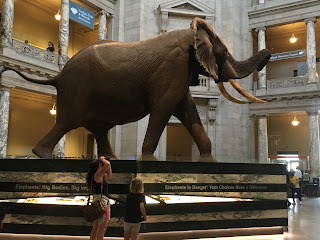The Smithsonian Institution is the world’s largest museum, educator and research institute in the world. We decided to go to the National Museum of Natural History first...OMG.. it was huge..first off and what a museum ... it is located on the National Mall and admission is free and it is open 364 days a year. With 7.1 million visitors, it is the fourth most visited museum and the most visited natural history museum in the world. Opened in 1910, this was one of the first Smithsonian buildings constructed exclusively to hold the national collections and research facilities. The main building has an overall area of 1,500,000 square feet with 325,000 square feet of exhibition and public space. It’s an all day affair!
The Smithsonian has a approximate 127.3 million artifacts and specimens...More specifically, the collections include 30 million insects, 4.5 million plants preserved in the Museum’s herbarium, 7 million fish stored in liquid-filled jars and 3.5 million specimens are out on loan every year!
HALL OF GEOLOGY GEMS AND MINERALS
The Museum also houses the National Gem and Mineral Collection and this is one of the most significant collections of its kind in the world. This collection includes some of the most famous gems in the world...the Hope Diamond and the Star of Asia Sapphire...this is one of the largest sapphires in the world.
HALL OF HUMAN ORIGINS
This hall is dedicated to the discovery and understanding of human origins, specimens include 75 replica skulls, an actual Neanderthal fossil along with a whole skeleton!
DINOSAURS/HALL OF PALEOBIOLOGY
The Hall of Dinosaurs has fossilized skeletons and cast models, including a Tyrannosaurs Rex. The Triceratops exhibit shows the first accurate dinosaur skeleton in virtual motion, achieved through the use of scanning and digital technology. The collection consists of 46 complete and important specimens of dinosaurs.
There is also the Hall of Mammals, Insect Zoo, Oceans Hall and so many more...
This Museum was fabulous...we spent the whole day in it and still didn’t see everything. The ever enduring curiosity of the Museums explorers have led them to the four corners of the earth. They have traveled to the peaks of the Andes, down into to ocean depths, deep in the rain forests of South America and the deserts of Asia. Researchers have collect specimens of fossils, minerals, rocks, plants, animals, tools and artworks for more than 150 years. There are now over 126 million items in their the ever-growing collections!
this is the Venus of Wellendorf, she is special to me, I wrote a paper about her in college and I have been fasinated with her ever since!
this is the Venus of Wellendorf, she is special to me, I wrote a paper about her in college and I have been fasinated with her ever since!
The Museum sometimes wonders whether they need to keep adding “stuff” to their collections. But in fact they have only skimmed the surface when it comes to understanding the natural world and humanity’s place in it, so there is a great need for more “stuff”
This museum houses the largest, most comprehensive natural history collection in the world and by comparing items gathered in different eras and regions, our scientists learn how the world has varied across time and space. This museum is dedicated to inspiring curiosity, discovery, and learning about the natural world through its unparalleled research, collections, exhibitions, and education outreach programs.














No comments:
Post a Comment